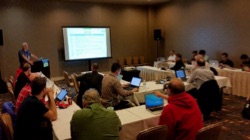
The second day of IETF 92 is a big one for DNSSEC with both the DNSOP and DANE working groups meeting back to back in the afternoon. There’s also the 6LO working group looking at IPv6 in “resource constrained” environments such as the Internet of Things (IoT) and the day begins with Homenet exploring how we create better home networks based on IPv6. And in the midst of that will be the IDR working group working to improve the Internet’s routing infrastruture! Here’s what today looks like for us…
NOTE: If you are unable to attend IETF 92 in person, there are multiple ways to participate remotely.
We start in the 0900-1130 CDT block in the International Room where the Homenet working group will be meeting. As Phil Roberts explained in his Rough Guide to IETF 92 post about IPv6:
the Homenet working group is doing a lot of interesting work producing open standards for protocols to implement robust networks in homes of the future, all based on IPv6. The topics include routing, addressing, naming, and security. It’s exciting to see new standards work for such a potentially huge area for extending the reach of open standards in networks that matter to people around the world.
Beyond IPv6, we’re also monitoring Homenet for possibilities where DNSSEC and TLS can help improve the security of those home networks.
As was curiously the case yesterday, the 1300-1500 CDT session block does not contain any of the regular groups we follow, but you might find us in HTTPBIS hearing about the next version of HTTP, in NETCONF learning about network configuration proposals (the zero touch provisioning draft looks interesting), or over in ACE understanding new ideas to make the Internet of Things (IoT) more secure.
Speaking of IoT, the 1520-1720 CDT session block is one in which we’ll be split across three different working group sessions, one of which will be IoT focused. The 6LO working group, formally known as the IPv6 over Networks of Resource Constrained Nodes WG, has a packed agenda looking at how IPv6 works in IoT environments. Transmitting IPv6 packets over near field communications (NFC), security and privacy, multicast technologies and multiple discussions of the IoT bootstrapping process… it all should make for an interesting discussion for those folks looking to get IP everywhere!
Simultaneously over in the Far East Room, the Inter-Domain Routing (IDR) working group will be looking at ways to improve the Internet’s routing infrastructure. Andrei wrote more about some of the routing discussions happening at IETF 92. I’m interested in the draft here about route leaks, as I find that area fascinating.
However, I’ll be over in the Gold Room (virtually, as I am remote for this meeting) for the DNS Operations (DNSOP) working group that has a VERY packed agenda looking at how to improve the operations of the Domain Name System (DNS). As I wrote in my Rough Guide to IETF 92 post, this session has a good number of drafts related to “DNS security” in general. I expect there to be some vigorous discussion around the restriction of “meta queries” such as the ANY query. There are multiple drafts on the agenda about reserving new top-level domains (TLDs) such as .onion, which inevitably gets discussion. The QNAME minimization is important for DNS privacy/confidentiality… and there are a range of other discussions that will be had related to making DNS work better, faster and be more secure.
We’ll end the day in the 1730-1830 CDT block with the DANE Working Group focused on the DANE protocol and how it can be used to add a layer of trust to TLS and SSL certificates. This is incredibly important work and while the agenda for today has only one presentation about DANE and S/MIME, I expect based on the strong activity on the DANE mailing list that other topics will be brought up.
When the sessions are all over, Chris and the many folks in Dallas will no doubt head to the IETF Social Event, while those of us who are remote will have a bit of break before heading into Day 3. Speaking of attending remotely, please do remember that multiple options to participate are available at http://www.ietf.org/live/
For some more background, please read these Rough Guide posts from Andrei, Phil and I:
- IETF 92: DNSSEC, DANE and DNS Security
- IETF 92: All About IPv6
- IETF 92: Routing Resilience and Security
Relevant Working Groups:
- homenet (Home Networking) WG
Tuesday, 24 March 0900-1130 CDT, International
Agenda: https://datatracker.ietf.org/meeting/92/agenda/homenet/
Documents: https://datatracker.ietf.org/wg/homenet/documents/
Charter: https://datatracker.ietf.org/wg/homenet/charter/
- 6lo (IPv6 over Networks of Resource Constrained Nodes) WG
Tuesday, 24 March 1520-1720 CDT, International
Agenda: https://datatracker.ietf.org/meeting/92/agenda/6lo/
Documents: https://datatracker.ietf.org/wg/6lo/documents/
Charter: https://datatracker.ietf.org/doc/charter-ietf-6lo/
- idr (Inter-Domain Routing Working Group) WG
Tuesday, 24 March, 1520-1720 CDT, Far East
Agenda: https://datatracker.ietf.org/meeting/92/agenda/idr/
Documents: https://datatracker.ietf.org/wg/idr/
Charter: https://datatracker.ietf.org/wg/idr/charter/
- dnsop (DNS Operations) WG
Tuesday, 24 March 2015, 1520-1720 CDT, Gold
Agenda: https://datatracker.ietf.org/meeting/92/agenda/dnsop/
Documents: https://datatracker.ietf.org/wg/dnsop/
Charter: http://tools.ietf.org/wg/dnsop/charters/
- dane (DNS-based Authentication of Named Entities) WG
Tuesday, 24 March 2015, 1730-1830 CDT, Venetian
Agenda: https://datatracker.ietf.org/meeting/92/agenda/dane/
Documents: https://datatracker.ietf.org/wg/dane/
Charter: http://datatracker.ietf.org/wg/dane/charter/
For more background on what is happening at IETF 92, please see our “Rough Guide to IETF 92″ posts on the ITM blog:
- Rough Guide to IETF 92: Welcome to Texas, Y’all!
- Routing Resilience and Security
- Scalability & Performance
- IPv6
- DNSSEC, DANE, and DNS Security
- Trust, Identity, and Privacy
- Strengthening the Internet
If you are at IETF 92 in Dallas, please do feel free to say hello to our Chris Grundemann. And if you want to get started with IPv6, DNSSEC or one of our other topics, please visit our “Start Here” page to find resources appropriate to your type of organization.
Image: a photo by Chris Grundemann of the 6man working group.








 On the fourth day of
On the fourth day of 
